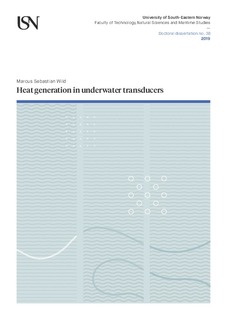| dc.contributor.advisor | Hjelmervik, Karina Bakkeløkken | |
| dc.contributor.advisor | Hoff, Lars | |
| dc.contributor.advisor | Bring, Martin | |
| dc.contributor.author | Wild, Marcus Sebastian | |
| dc.date.accessioned | 2019-09-04T05:54:57Z | |
| dc.date.available | 2019-09-04T05:54:57Z | |
| dc.date.issued | 2019 | |
| dc.identifier.isbn | 978-82-7860-381-9 | |
| dc.identifier.issn | 2535-5252 | |
| dc.identifier.uri | http://hdl.handle.net/11250/2612333 | |
| dc.description.abstract | Acoustic transducers are used for a variety of applications, ranging from medical to maritime uses. In the maritime sector, underwater transducers can be used for appli- cations such as seabed mapping, fishing and communication. Significant strides have been made in each of these applications, resulting in high performance transducers. However, as these transducers are being used with increasingly higher power, duty cycles and wider bandwidth, the heat generation within these systems has become an important design criteria. Indeed, it is clear that excessive temperatures can cause damage to underwater transducers.
One of the key contributors to the energy dissipation in underwater transducers is the active part, namely the piezoelectric material. The thesis concentrates on predicting the energy dissipation in a piezoelectric rod given known external conditions such as driving voltage and frequency of operation. To achieve this, the work initially focused on developing a characterisation method to characterise the relevant piezoelectric constants based on a global optimisation algorithm and a 1D or 3D FEM model. It was found that the piezoelectric loss, a parameter normally considered negligible, was an independent parameter which could be estimated through the developed characterisation method. In addition to this finding, it was shown the use of two cost functions in the global optimisation algorithm could negate the effects of noise on the characterised material constants. Finally, a local optimisation algorithm was used instead of a global optimisation algorithm to demonstrate that these types of methods can converge to local minima without adequate initial material constants.
The next step of the PhD was to predict the power dissipation density in the piezoelectric rod given the characterised material parameters. The initial goal was to quantify the contribution from the mechanical, electrical and piezoelectric losses to determine whether the piezoelectric loss is indeed negligible. However, the most significant finding of this step was that the mechanical, electrical and piezoelectric contributions changed depending on the piezoelectric constitutive form used. This demonstrates that although the losses are associated with a specific mechanism under Holland's notation, such as mechanical, electrical and piezoelectric energy dissipation, they are in fact not associated directly with the physical energy dissipation mechanisms and must not be treated in this manner. This finding is emphasised by the fact that the contribution to the power dissipation from the imaginary part of the piezoelectric constant is negative. In addition, this study on the power dissipation in piezoelectric materials demonstrated that the loss parameters that originate from the BVD model should not be used as the loss parameters under Holland's notation as this results in a different power dissipation.
The final step of the PhD was to validate the temperature rise predicted from the characterised material parameters by comparing it to the measured temperature rise. This stage of the PhD found that the spatial distribution of the temperature rise across the length of the piezoelectric rod was better modelled by the predicted spatial distribution of the power dissipation density as opposed to a spatially constant power dissipation density. It also determined that from a practical point of view, using a power dissipation density that is constant in space was adequate for most purposes as the differences were not large. | nb_NO |
| dc.language.iso | eng | nb_NO |
| dc.publisher | University of South-Eastern Norway | nb_NO |
| dc.relation.ispartofseries | Doctoral dissertations at the University of South-Eastern Norway;38 | |
| dc.relation.haspart | Article 1 M. Wild, K. Hjelmervik, L. Hoff and M. Bring, "Characterising piezoelectric material parameters through a 3D FEM and optimisation algorithm," in OCEANS 2017 - Aberdeen, pp. 1-5, IEEE, 2017, doi: 10.1109/OCEANSE.2017.8084983 | nb_NO |
| dc.relation.haspart | Article 2: M. Wild, M. Bring, L. Hoff and K. Hjelmervik, "Characterization of Piezoelectric Material Parameters Through a Global Optimization Algorithm,", IEEE Journal of Oceanic Engineering, pp. 1-9,, 2019, doi: 10.1109/JOE.2018.2882262 | nb_NO |
| dc.relation.haspart | Article 3: M. Wild, M. Bring, E. Halvorsen, L. Hoff and K. Hjelmervik, "The challenge of distinguishing mechanical, electrical and piezoelectric losses," Journal of Acoustical Society of America, 144(4), pp. 2128-2134, 2018, doi: 10.1121/1.5057443 | nb_NO |
| dc.relation.haspart | Article 4: M. Wild, M. Bring, L. Hoff and K. Hjelmervik, "Comparison of two models for power dissipation and temperature in piezoelectric transducers," in 2018 IEEE International Ultrasonics Symposium (IUS), pp. 1-4, IEEE, 2018, doi: 10.1109/ULTVSYM.2018.8580069 | nb_NO |
| dc.relation.haspart | Article 5: M. Wild, T. Huynh, M. Bring, L. Hoff and K. Hjelmervik, "Estimating the spatial temperature distribution in a piezoelectric rod," submitted to IEEE Transactions on Ultrasonics, Ferroelectrics and Frequency Control, pp. 1-7, 2019 | nb_NO |
| dc.title | Heat generation in underwater transducers | nb_NO |
| dc.type | Doctoral thesis | nb_NO |
| dc.subject.nsi | VDP::Teknologi: 500::Elektrotekniske fag: 540 | nb_NO |
| dc.source.pagenumber | 86 | nb_NO |
